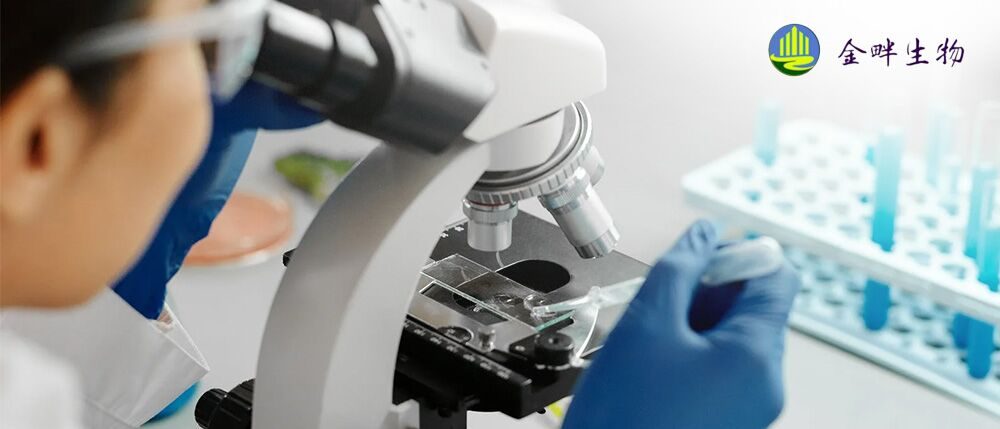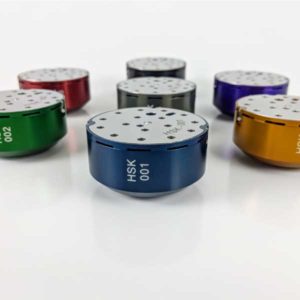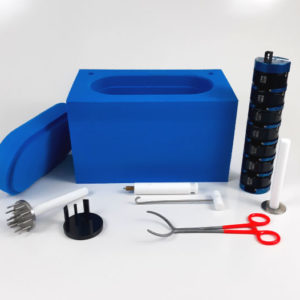Universal V1-Puck (Uni-Puck)
The Universal V1-Puck (Unipuck) is a sample pin storage and shipping container compatible with many automated sample mounting systems. The V1-puck holds 16 MiTeGen sample bases/pins. It consists of two parts shown in the image: 1) the sample enclosure (left) and 2) the sample base piece (right).
Each part of the V1-puck has a unique serial number for identification. Custom serial numbers are available if requested at time of order.
Universal V1-Puck (Unipuck) 是一种样品针存储和运输容器,与许多自动样品安装系统兼容。 V1-puck 可容纳 16 个 MiTeGen 样品底座/引脚。 它由图像中显示的两部分组成:1) 样品外壳(左)和 2)样品底座(右)。
V1-puck 的每个部件都有一个唯一的序列号用于识别。 如果在订购时要求,可提供自定义序列号。

Product Information 其他相关产品:
The tools for handling Universal V1-pucks are available individually or in our convenient Uni-puck Starter Kits. Looking for a set of pucks, or outfitting a facility? You can see our bundle options available here: Bulk pricing options
-
Universal Puck (Uni-Puck) Starter Kits
To get you up–and–running to the beamline All the components youThe Universal Puck ProjectA collaboration to develop the uni-puck, a new standard sample pin storage and shipping container.
The uni-puck has been designed to be compatible with all robotic mounting systems currently in use at synchrotrons in the United States and many systems used abroad, requiring minimal changes to the robotic hardware of each system.

Introduction
The availability of robotic sample mounting systems continues to increase at synchrotron sources. (See smb.slac.stanford.edu/robosyncfor a list of available devices). Although the majority of these systems are compatible with Hampton-style magnetic cryo-pins, many types of containers are used for sample pin transportation and storage.
Currently at synchrotron stations in the United States there are three main sample storage containers used: the ALS puck, the SSRL cassette, and the MSC magazine. The costs to purchase these containers and associated cryo-tools and the effort required to master their use has become a significant impediment to groups seeking to take advantage of more than one of these facilities.
In an effort to minimize this burden, a collaboration was formed between the ALS, APS SBC-CAT, and SSRL staff. This group first proposed construction of a sorting system that would transfer sample pins between the most commonly used containers. However, it was observed that it could be possible to develop a sample storage container that would be compatible with all the sample mounting systems currently in use in the United States and many of the systems used abroad. Therefore, during a meeting at the 2004 ACA conference in Chicago the group decided to develop a universal container. We have received a lot of positive feedback in response to this effort. In particular, many have joined this collaboration including developers at the NSLS, APS, and CHESS and of commercial systems. These developers were asked to test the V1 uni-puck with their automated mounting systems and provide feedback on the design with the goal of cross compatibility and reliability. Through the collaborative efforts of all involved, a first version of the universal container, the V1 uni-puck has been completed. The V1 uni-puck was released for use at the ALS sector 5.0 beam lines and at the SSRL macromolecular crystallography beam lines with test users. Once groups have more experience using the V1 uni-puck, a second version (V2) may be released if necessary for improved performance.
Design
The outside form factor of the new universal container (uni-puck), resembles a standard ALS puck and for this reason will be compatible with the standard ALS cryo-tools and fit inside the ALS shipping dewar canister. Unlike the ALS puck, the pins are held inside the container using rare earth magnets which are more durable and more strongly and reliably hold the pins in place. Magnets are used in both the enclosure piece and base piece of the uni-puck. The uni-puck enclosure resembles an SSRL cassette as it contains ports that are nearly identical to those in an SSRL cassette. The uni-puck also provides the same clearance around the sides and bottom of the sample pin as an MSC magazine and the base piece shares a similar hole and slot for alignment inside the dispensing dewar.
The universal puck consists of two parts: 1) the base piece and 2) the sample enclosure. Some key differences between the original ALS puck and universal puck are illustrated in the figures below.


Both the universal puck enclosure and the base contain magnets and the assembly will hold together by magnetic force. Therefore, the side clips used on the ALS puck for this purpose are not necessary. However to enable the universal puck parts to fit interchangeably with ALS puck parts, clearance and mounting holes for these clips are provided. Interchangeability of the universal puck base and enclosure with the ALS puck parts enable rapid transfer of samples between these two containers.
Compatibility of Specific Robotic SystemsThe ALS Robot (Berkeley Automated Mounting system)
The uni-puck base piece is used inside the ALS dispensing dewar. This universal base will work in the ALS robotic systems interchangeably with the original ALS puck base. Because the sample pins are held in the same position, minimal hardware modifications or reprogramming is required.
Because the outside form factor is similar, the V1 uni-puck is compatible with the standard ALS cryo-tools and shipping dewar canister. Additionally, the uni-puck base and enclosure pieces fit on the original ALS puck enabling rapid transfer between the two types of containers.
Members of the ALS beam line development group are taking part in the universal puck project and will ensure compatibility and reliability with their automounter.

The Stanford Automated Mounting System (SAM)
The enclosure piece of the universal puck is used inside the SAM dispensing dewar. This piece contains magnetic cavities nearly identical to those in a SSRL cassette. To adapt the enclosure piece to the standard SAM setup an adaptor cassette has been developed. Four universal pucks may be inserted into one adaptor cassette. The adaptor is then inserted inside the robot dispensing dewar using the cassette transport handle (see below).
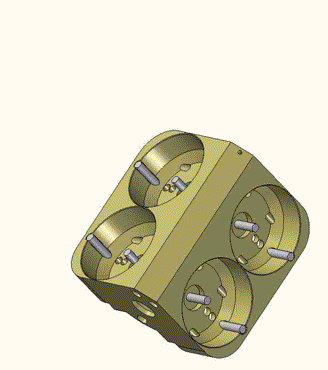

The original SSRL cassettes will continue to work with the SAM system. Within the SSRL dispensing dewar the 3 cassette locations are each capable of interchangeably holding an SSRL cassette or an adaptor cassette containing 4 universal pucks.
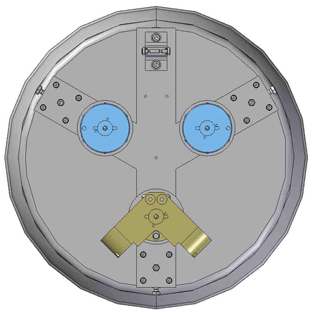
Once the universal container project and adaptor cassette development is complete, SSRL users will have the option to use cassettes or uni-pucks and the SAM system will be programmed to sort samples between these two options.
APS SBC-CAT Automatic Mounting SystemCurrently the SBC-CAT system works with MSC magazines. To work with the uni-puck, the system will be reprogrammed and a new dewar base plate will be developed that can accommodate both MSC magazines and universal puck bases. Users will then have the option to use either container.
For added reliability when picking up a sample pin, the SBC-CAT robot grippers surround the bottom edge of the pin trapping it in place (rather than gripping the side of the pin and relying on friction to hold it). To accommodate this gripper, the uni-puck base provides additional clearance around the bottom and side of the pin base. This clearance is equal to that provided by the MSC magazine.
Members of the APS SBC-CAT development group have been instrumental in the universal puck project and will ensure compatibility and reliability with their automounter.
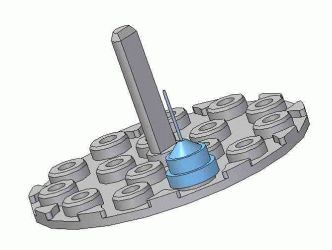
Commercially Available Systems
This universal container concept has received positive feedback from the commercial manufacturers of robotic sample mounting systems (MSC, Bruker, and Mar). Moreover, MSC and Bruker representatives feel that it would be rather straight-forward for them to offer an alternative dewar base plate and programming to accommodate the proposed universal puck design.
Fabrication of an alternative enclosure, that would contain traditional cryo-vials and mate with the universal puck base, will make it easy to transfer samples from vials into pucks and enable compatibility with even more robotic mounting systems.

